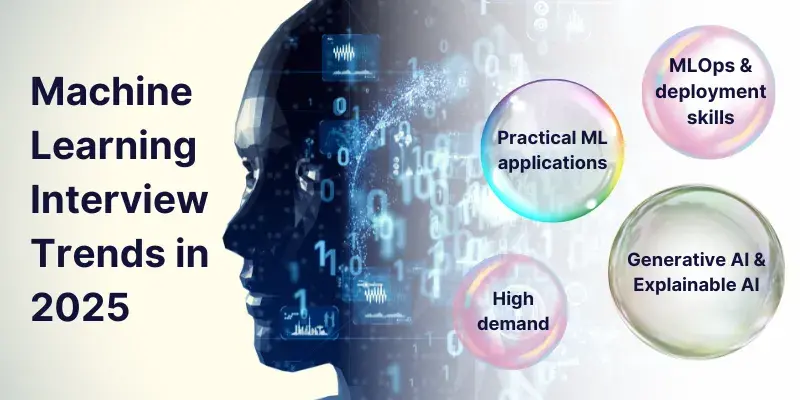Top Machine Learning Interview Questions & Answers for 2025

Machine learning is booming, and so is the demand for skilled ML engineers and data scientists.
In 2025, hiring trends are shifting with the rise of AutoML, Edge AI, and Large Language Models (LLMs) like ChatGPT. Companies are looking for candidates who understand both ML fundamentals and cutting-edge AI innovations.
This guide covers top machine learning interview questions across beginner, intermediate, and advanced levels. You'll also get ML interview tips and resources to ace your next AI and ML job interview.
Machine Learning Interview Trends in 2025

The ML job market is evolving with new technologies and hiring strategies. Here are key trends:
- High demand for ML engineers, data scientists, and AI specialists.
- Generative AI & Explainable AI play a big role in interviews.
- Companies focus on practical ML applications over just theoretical knowledge.
- MLOps & deployment skills are crucial for real-world ML roles.
Beginner-Level Machine Learning Interview Questions
1. Fundamental ML Concepts
Q. What is Machine Learning?
A. ML is a field of AI that enables computers to learn patterns from data.
Example: Netflix recommending shows based on your watch history.
Q. Difference between Supervised, Unsupervised, and Reinforcement Learning?
A. Supervised Learning: Labeled data, e.g., spam email detection.
Unsupervised Learning: No labels, e.g., customer segmentation.
Reinforcement Learning: Learning via rewards, e.g., self-driving cars.
Q. What are the key assumptions of a Linear Regression model?
A. Linearity, Independence of errors, Homoscedasticity (constant variance of errors), No multicollinearity.
Q. What is Overfitting, and how can it be avoided?
A. Overfitting happens when a model learns noise instead of patterns.
Fixes: Cross-validation, regularization (L1/L2), and pruning.
Q. Explain Bias-Variance Tradeoff.
A. High Bias: Model is too simple (underfitting).
High Variance: Model is too complex (overfitting).
Solution: Find the right balance with proper model complexity.
2. Python & ML Libraries
Q. What are the most commonly used Python libraries for ML?
A. NumPy: Numerical operations
Pandas: Data manipulation
Scikit-learn: ML algorithms
TensorFlow & PyTorch: Deep learning
Q. Difference between NumPy and Pandas in ML?
A. NumPy: Handles arrays and numerical operations.
Pandas: Works with tabular data (DataFrames).
Q. What is Scikit-learn, and why is it important?
A. A Python library with ML algorithms for classification, regression, clustering, and more.
Intermediate-Level Machine Learning Interview Questions
1. Model Training & Evaluation
Q. How do you handle missing or corrupted data?
A. Remove rows, fill missing values (mean, median, mode), or use ML models to predict them.
Q. What is Cross-Validation, and why is it useful?
A. Splits data into multiple training/testing sets to improve model reliability.
Common technique: k-fold cross-validation.
Q. How do you choose the right evaluation metric for a classification problem?
A. Accuracy: When classes are balanced.
Precision & Recall: When classes are imbalanced.
F1-Score: Harmonic mean of precision and recall.
2. Optimization & Regularization
Q. What is Gradient Descent, and how does it work?
A. An optimization algorithm used to minimize loss in ML models.
Types: Batch, Stochastic, and Mini-batch Gradient Descent.
Q. Explain L1 and L2 regularization (Lasso vs. Ridge Regression).
A. L1 (Lasso): Shrinks some coefficients to zero (feature selection).
L2 (Ridge): Penalizes large coefficients but keeps all features.
Q. What is Hyperparameter Tuning? Name common techniques.
A. Optimizing model parameters for better performance.
Techniques: Grid Search, Random Search, Bayesian Optimization.
Advanced-Level Machine Learning Interview Questions
1. Deep Learning & Neural Networks
Q. What are CNNs and RNNs? Where are they used?
A. CNNs: Used for image processing (e.g., facial recognition).
RNNs: Used for sequential data (e.g., speech recognition).
Q. How does Transformer architecture power models like ChatGPT?
A. Uses self-attention mechanism to process text efficiently.
Q. What is the role of Attention Mechanism in NLP models?
A. Helps models focus on important words in long sentences.
2. AutoML & Large Language Models (LLMs)
Q. What is AutoML, and how is it changing ML development??
A. Automates model selection, training, and hyperparameter tuning.
Example: Google AutoML, H2O.ai.
Q. How do you fine-tune a pre-trained large language model (LLM)?
A. Use transfer learning with domain-specific data.
3. ML in Production & Deployment
Q. What are the key challenges in deploying ML models at scale?
A. Data drift, latency, scalability, monitoring.
Q. What is MLOps, and why is it important?
A. Combines ML and DevOps for scalable ML model deployment.
Q. How do you handle model drift in production?.
A. Monitor performance, retrain models regularly.
Behavioral & Situational Questions
Here are some key suggestions on how to answer these Machine Learning behavioral and situational questions effectively in an interview:
1. Tell us about a challenging ML project you worked on.
✅ Use the STAR Method (Situation, Task, Action, Result):
- Situation: Briefly describe the problem you were solving.
- Task: Explain your specific role in the project.
- Action: Detail the ML techniques, algorithms, or optimizations you used.
- Result: Highlight measurable impact (e.g., accuracy improvement, latency reduction, business impact).
✅ Mention trade-offs & lessons learned: Talk about model selection, hyperparameter tuning, and deployment considerations.
2. How do you stay updated with the latest ML advancements?
✅ Mention multiple sources: Cover research papers, blogs, online courses, and ML communities to show a well-rounded approach.
✅ Highlight hands-on learning: Mention Kaggle competitions, open-source contributions, or personal projects where you apply new concepts.
✅ Stay relevant to the job: If the role is in NLP, discuss recent trends in LLMs. If it’s in CV, talk about transformer architectures like ViTs.
3. Explain a time when you had to explain ML concepts to a non-technical team?
✅ Simplify complex topics: Use analogies or real-world examples instead of technical jargon.
✅ Use data visualization: Mention dashboards, charts, or storytelling techniques you used to communicate insights.
✅ Tie ML insights to business impact: Show how your explanation helped stakeholders make data-driven decisions.
Would you like specific mock answers for any of these?Pro Tips for Cracking ML Interviews in 2025
- Common mistakes to avoid: Not explaining thought process, ignoring edge cases.
- Best platforms for ML interview prep: Leetcode, Kaggle, Coursera, Fast.ai.
- Latest resources:
- Blogs: Towards Data Science, Papers With Code.
- Newsletters: The Batch (DeepLearning.AI), ML Engineer Newsletter.
Conclusion
Ready to ace your ML interviews in 2025?
Enroll in Certification Program in Applied Generative AI and gain the skills, hands-on experience, and confidence to land your dream ML role. Master key concepts, work on real-world projects, and get interview-ready with expert guidance.
Join now and take the next step in your ML career!
FAQs
Q. What are the most commonly asked machine learning interview questions in 2025?
A. ML interview questions cover fundamental concepts (bias-variance tradeoff, regularization), coding problems (data structures, ML model implementation), and advanced topics like LLMs, MLOps, and model deployment. Companies also focus on real-world problem-solving and ML system design.
Q. How do I prepare for a machine learning job interview?
A. Focus on coding (Python, SQL, data structures), build real-world ML projects, and master ML algorithms, evaluation metrics, and system design. Mock interviews, Kaggle practice, and understanding business applications of ML can give you an edge.
Q. How do I prepare for a machine learning job interview?
A. The difficulty varies—entry-level roles test basic ML knowledge and coding, while mid/senior roles require expertise in model optimization, deployment, scalability, and deep learning architectures. Companies may also test MLOps and cloud ML deployment.
Q. Which programming languages should I know for an ML interview?
A. Python is the most essential for ML, with libraries like NumPy, Pandas, Scikit-Learn, TensorFlow, and PyTorch. Knowledge of SQL (for data querying) and R (for statistical analysis) can be beneficial, depending on the role.
Q. How do I answer ML interview questions if I have no prior work experience?
A. Showcase personal projects, Kaggle competitions, open-source contributions, and blog writing to demonstrate your skills. Building and deploying an end-to-end ML model (on AWS/GCP) can also make your portfolio stand out.